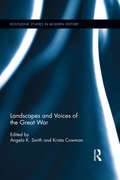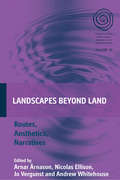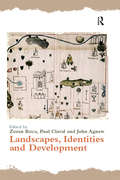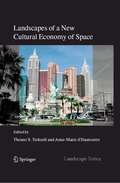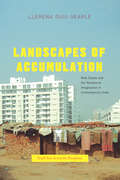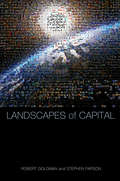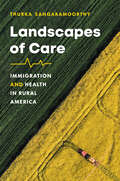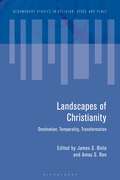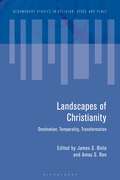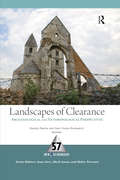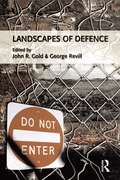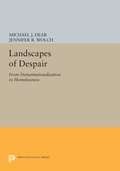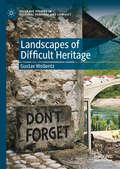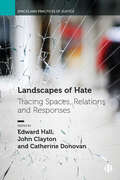- Table View
- List View
Landscapes and Voices of the Great War (Routledge Studies in Modern History #22)
by Angela K. Smith Krista CowmanThis volume aims to provide a wider view of First World War experience through focusing on landscapes less commonly considered in historiography, and on voices that have remained on the margins of popular understanding of the war. The landscape of the western front was captured during the conflict in many different ways: in photographs, paintings and print. The most commonly replicated voicing of contemporary attitudes towards the war is that of initial enthusiasm giving way to disillusionment and a sense of overwhelming futility. Investigations of the many components of war experience drawn from social and cultural history have looked to landscapes and voices beyond the frontline as a means of foregrounding different perspectives on the war. Not all of the voices presented here opposed the war, and not all of the landscapes were comprised of trenches or flanked by barbed wire. Collectively, they combine to offer further fresh insights into the multiplicity of war experience, an alternate space to the familiar tropes of mud and mayhem.
Landscapes and Voices of the Great War (Routledge Studies in Modern History #22)
by Angela K. Smith Krista CowmanThis volume aims to provide a wider view of First World War experience through focusing on landscapes less commonly considered in historiography, and on voices that have remained on the margins of popular understanding of the war. The landscape of the western front was captured during the conflict in many different ways: in photographs, paintings and print. The most commonly replicated voicing of contemporary attitudes towards the war is that of initial enthusiasm giving way to disillusionment and a sense of overwhelming futility. Investigations of the many components of war experience drawn from social and cultural history have looked to landscapes and voices beyond the frontline as a means of foregrounding different perspectives on the war. Not all of the voices presented here opposed the war, and not all of the landscapes were comprised of trenches or flanked by barbed wire. Collectively, they combine to offer further fresh insights into the multiplicity of war experience, an alternate space to the familiar tropes of mud and mayhem.
Landscapes Beyond Land: Routes, Aesthetics, Narratives (EASA Series #19)
by Arnar Árnason Nicolas Ellison Jo Vergunst Andrew WhitehouseLand is embedded in a multitude of material and cultural contexts, through which the human experience of landscape emerges. Ethnographers, with their participative methodologies, long-term co-residence, and concern with the quotidian aspects of the places where they work, are well positioned to describe landscapes in this fullest of senses. The contributors explore how landscapes become known primarily through movement and journeying rather than stasis. Working across four continents, they explain how landscapes are constituted and recollected in the stories people tell of their journeys through them, and how, in turn, these stories are embedded in landscaped forms.
Landscapes, Identities and Development
by Zoran Roca Paul Claval John AgnewBringing together theoretical and empirical research from 22 countries in Europe, North America, Australia, South America and Japan, this book offers a state-of-the-art survey of conceptual and methodological research and planning issues relating to landscape, heritage, [and] development. It has 30 chapters grouped in four main thematic sections: landscapes as a constitutive dimension of territorial identities; landscape history and landscape heritage; landscapes as development assets and resources; and landscape research and development planning. The contributors are scholars from a wide range of cultural and professional backgrounds, experienced in fundamental and applied research, planning and policy design. They were invited by the co-editors to write chapters for this book on the basis of the theoretical frameworks, case-study research findings and related policy concerns they presented at the 23rd Session of PECSRL - The Permanent European Conference for the Study of the Rural Landscape, organized by TERCUD - Territory, Culture and Development Research Centre, Universidade Lusófona, in Lisbon and Óbidos, Portugal, 1 - 5 September 2008. With such broad inter-disciplinary relevance and international scope, this book provides a valuable overview, highlighting recent findings and interpretations on historical, current and prospective linkages between changing landscapes and natural, economic, cultural and other identity features of places and regions; landscape-related identities as local and regional development assets and resources in the era of globalized economy and culture; the role of landscape history and heritage as platforms of landscape research and management in European contexts, including the implementation of The European Landscape Convention; and, the strengthening of the landscape perspective as a constitutive element of sustainable development.
Landscapes, Identities and Development
by ZORAN ROCA, PAUL CLAVAL AND JOHN AGNEWBringing together theoretical and empirical research from 22 countries in Europe, North America, Australia, South America and Japan, this book offers a state-of-the-art survey of conceptual and methodological research and planning issues relating to landscape, heritage, [and] development. It has 30 chapters grouped in four main thematic sections: landscapes as a constitutive dimension of territorial identities; landscape history and landscape heritage; landscapes as development assets and resources; and landscape research and development planning. The contributors are scholars from a wide range of cultural and professional backgrounds, experienced in fundamental and applied research, planning and policy design. They were invited by the co-editors to write chapters for this book on the basis of the theoretical frameworks, case-study research findings and related policy concerns they presented at the 23rd Session of PECSRL - The Permanent European Conference for the Study of the Rural Landscape, organized by TERCUD - Territory, Culture and Development Research Centre, Universidade Lusófona, in Lisbon and Óbidos, Portugal, 1 - 5 September 2008. With such broad inter-disciplinary relevance and international scope, this book provides a valuable overview, highlighting recent findings and interpretations on historical, current and prospective linkages between changing landscapes and natural, economic, cultural and other identity features of places and regions; landscape-related identities as local and regional development assets and resources in the era of globalized economy and culture; the role of landscape history and heritage as platforms of landscape research and management in European contexts, including the implementation of The European Landscape Convention; and, the strengthening of the landscape perspective as a constitutive element of sustainable development.
Landscapes of a New Cultural Economy of Space (Landscape Series #5)
by Theano S. Terkenli Anne-Marie D'HauteserreMaking sense of new cultural economies, it is argued, needs consistent attention to the resonances of individual lives. Otherwise, a discussion of cultural economies remains suspended in a detached virtualism (Miller, 2000). The idea of the remaking of geographies and cultural economies remains, necessarily, a consistent search to make the subject dynamic in its resonance with the contemporary world. In recent debates concerning the reframing of the cultural economies of geography, there is an evidence of increasing acknowledgement of the overlooked importance of subjectivities within geographical explanation. This has often been difficult when trying to attend to the large scale apparent dynamics of change. The shift of geographies to focus upon cultural economies combines two profound threads that inform this chapter: the acknowledgement of the breadth and inclusivity of what economies are and the refusal mutually to isolate the cultural and the economic. Thus the economic becomes engaged and even framed in relation to the cultural, and vice versa. Such an appraisal makes more robust the limits of ‘either – or’ claims from these two grounding components of geographical thinking and its representation of the world. These themes are sustained in different ways across the chapters of this book. This chapter seeks to build a critical discourse concerning space, embodied practice and lay knowledge. It does this in order to address the mechanisms through which individuals are engaged in the processes of new cultural economies.
Landscapes of Accumulation: Real Estate and the Neoliberal Imagination in Contemporary India (South Asia Across the Disciplines)
by Llerena Guiu SearleOver the past few decades, India has experienced a sudden and spectacular urban transformation. Gleaming business complexes encroach on fields and villages. Giant condominium communities offer gated security, indoor gyms, and pristine pools. Spacious, air-conditioned malls have sprung up alongside open-air markets. In Landscapes of Accumulation, Llerena Guiu Searle examines India’s booming developments and offers a nuanced ethnographic treatment of late capitalism. India’s land, she shows, is rapidly transforming from a site of agricultural and industrial production to an international financial resource. Drawing on intensive fieldwork with investors, developers, real estate agents, and others, Searle documents the new private sector partnerships and practices that are transforming India’s built environment, as well as widely shared stories of growth and development that themselves create self-fulfilling prophecies of success. As a result, India’s cities are becoming ever more inaccessible to the country’s poor. Landscapes of Accumulation will be a welcome contribution to the international study of neoliberalism, finance, and urban development and will be of particular interest to those studying rapid—and perhaps unsustainable—development across the Global South.
Landscapes of Accumulation: Real Estate and the Neoliberal Imagination in Contemporary India (South Asia Across the Disciplines)
by Llerena Guiu SearleOver the past few decades, India has experienced a sudden and spectacular urban transformation. Gleaming business complexes encroach on fields and villages. Giant condominium communities offer gated security, indoor gyms, and pristine pools. Spacious, air-conditioned malls have sprung up alongside open-air markets. In Landscapes of Accumulation, Llerena Guiu Searle examines India’s booming developments and offers a nuanced ethnographic treatment of late capitalism. India’s land, she shows, is rapidly transforming from a site of agricultural and industrial production to an international financial resource. Drawing on intensive fieldwork with investors, developers, real estate agents, and others, Searle documents the new private sector partnerships and practices that are transforming India’s built environment, as well as widely shared stories of growth and development that themselves create self-fulfilling prophecies of success. As a result, India’s cities are becoming ever more inaccessible to the country’s poor. Landscapes of Accumulation will be a welcome contribution to the international study of neoliberalism, finance, and urban development and will be of particular interest to those studying rapid—and perhaps unsustainable—development across the Global South.
Landscapes of Accumulation: Real Estate and the Neoliberal Imagination in Contemporary India (South Asia Across the Disciplines)
by Llerena Guiu SearleOver the past few decades, India has experienced a sudden and spectacular urban transformation. Gleaming business complexes encroach on fields and villages. Giant condominium communities offer gated security, indoor gyms, and pristine pools. Spacious, air-conditioned malls have sprung up alongside open-air markets. In Landscapes of Accumulation, Llerena Guiu Searle examines India’s booming developments and offers a nuanced ethnographic treatment of late capitalism. India’s land, she shows, is rapidly transforming from a site of agricultural and industrial production to an international financial resource. Drawing on intensive fieldwork with investors, developers, real estate agents, and others, Searle documents the new private sector partnerships and practices that are transforming India’s built environment, as well as widely shared stories of growth and development that themselves create self-fulfilling prophecies of success. As a result, India’s cities are becoming ever more inaccessible to the country’s poor. Landscapes of Accumulation will be a welcome contribution to the international study of neoliberalism, finance, and urban development and will be of particular interest to those studying rapid—and perhaps unsustainable—development across the Global South.
Landscapes of Accumulation: Real Estate and the Neoliberal Imagination in Contemporary India (South Asia Across the Disciplines)
by Llerena Guiu SearleOver the past few decades, India has experienced a sudden and spectacular urban transformation. Gleaming business complexes encroach on fields and villages. Giant condominium communities offer gated security, indoor gyms, and pristine pools. Spacious, air-conditioned malls have sprung up alongside open-air markets. In Landscapes of Accumulation, Llerena Guiu Searle examines India’s booming developments and offers a nuanced ethnographic treatment of late capitalism. India’s land, she shows, is rapidly transforming from a site of agricultural and industrial production to an international financial resource. Drawing on intensive fieldwork with investors, developers, real estate agents, and others, Searle documents the new private sector partnerships and practices that are transforming India’s built environment, as well as widely shared stories of growth and development that themselves create self-fulfilling prophecies of success. As a result, India’s cities are becoming ever more inaccessible to the country’s poor. Landscapes of Accumulation will be a welcome contribution to the international study of neoliberalism, finance, and urban development and will be of particular interest to those studying rapid—and perhaps unsustainable—development across the Global South.
Landscapes of Accumulation: Real Estate and the Neoliberal Imagination in Contemporary India (South Asia Across the Disciplines)
by Llerena Guiu SearleOver the past few decades, India has experienced a sudden and spectacular urban transformation. Gleaming business complexes encroach on fields and villages. Giant condominium communities offer gated security, indoor gyms, and pristine pools. Spacious, air-conditioned malls have sprung up alongside open-air markets. In Landscapes of Accumulation, Llerena Guiu Searle examines India’s booming developments and offers a nuanced ethnographic treatment of late capitalism. India’s land, she shows, is rapidly transforming from a site of agricultural and industrial production to an international financial resource. Drawing on intensive fieldwork with investors, developers, real estate agents, and others, Searle documents the new private sector partnerships and practices that are transforming India’s built environment, as well as widely shared stories of growth and development that themselves create self-fulfilling prophecies of success. As a result, India’s cities are becoming ever more inaccessible to the country’s poor. Landscapes of Accumulation will be a welcome contribution to the international study of neoliberalism, finance, and urban development and will be of particular interest to those studying rapid—and perhaps unsustainable—development across the Global South.
Landscapes of Accumulation: Real Estate and the Neoliberal Imagination in Contemporary India (South Asia Across the Disciplines)
by Llerena Guiu SearleOver the past few decades, India has experienced a sudden and spectacular urban transformation. Gleaming business complexes encroach on fields and villages. Giant condominium communities offer gated security, indoor gyms, and pristine pools. Spacious, air-conditioned malls have sprung up alongside open-air markets. In Landscapes of Accumulation, Llerena Guiu Searle examines India’s booming developments and offers a nuanced ethnographic treatment of late capitalism. India’s land, she shows, is rapidly transforming from a site of agricultural and industrial production to an international financial resource. Drawing on intensive fieldwork with investors, developers, real estate agents, and others, Searle documents the new private sector partnerships and practices that are transforming India’s built environment, as well as widely shared stories of growth and development that themselves create self-fulfilling prophecies of success. As a result, India’s cities are becoming ever more inaccessible to the country’s poor. Landscapes of Accumulation will be a welcome contribution to the international study of neoliberalism, finance, and urban development and will be of particular interest to those studying rapid—and perhaps unsustainable—development across the Global South.
Landscapes of Capital
by Robert Goldman Stephen PapsonEvery era has its dominant representations. Just as landscape painters of previous centuries captured and expressed new modes of perceiving history, corporate advertisers now devise the imagined landscapes of global capitalism. Advertising functions as an omnipresent discursive form, publicly assembling and circulating the predominant tropes of our era. This project is based on the premise that corporate advertising’s landscapes help shape our epoch’s imaginative conceptualizations of the spatial relations, the temporal flows, and the cultural geographies that correspond to the emergence of a high-tech global economy. In Landscapes of Capital Robert Goldman and Steven Papson examine how corporate television ads from the last fifteen years have organized predominant images, tropes and narrative representations of a world in transition. The volume takes particular interest in how relations of space, time, speed, capital, technology and globalization are narratively represented in advertising. Goldman and Papson skillfully demonstrate how Capital represents itself at a moment of critical historical transition Ð the passage into high-tech globalization and the crises associated with it. They argue that corporate ads can be read to reveal how Capital represents itself and the world that is being wrought Ð in terms of the signifiers it prefers and the stories it tells.
Landscapes of Capital
by Robert Goldman Stephen PapsonEvery era has its dominant representations. Just as landscape painters of previous centuries captured and expressed new modes of perceiving history, corporate advertisers now devise the imagined landscapes of global capitalism. Advertising functions as an omnipresent discursive form, publicly assembling and circulating the predominant tropes of our era. This project is based on the premise that corporate advertising’s landscapes help shape our epoch’s imaginative conceptualizations of the spatial relations, the temporal flows, and the cultural geographies that correspond to the emergence of a high-tech global economy. In Landscapes of Capital Robert Goldman and Steven Papson examine how corporate television ads from the last fifteen years have organized predominant images, tropes and narrative representations of a world in transition. The volume takes particular interest in how relations of space, time, speed, capital, technology and globalization are narratively represented in advertising. Goldman and Papson skillfully demonstrate how Capital represents itself at a moment of critical historical transition Ð the passage into high-tech globalization and the crises associated with it. They argue that corporate ads can be read to reveal how Capital represents itself and the world that is being wrought Ð in terms of the signifiers it prefers and the stories it tells.
Landscapes of Care: Immigration and Health in Rural America (Studies in Social Medicine)
by Thurka SangaramoorthyThis insightful work on rural health in the United States examines the ways immigrants, mainly from Latin America and the Caribbean, navigate the health care system in the United States. Since 1990, immigration to the United States has risen sharply, and rural areas have seen the highest increases. Thurka Sangaramoorthy reveals that that the corporatization of health care delivery and immigration policies are deeply connected in rural America. Drawing from fieldwork that centers on Maryland's sparsely populated Eastern Shore, Sangaramoorthy shows how longstanding issues of precarity among rural health systems along with the exclusionary logics of immigration have mutually fashioned a "landscape of care" in which shared conditions of physical suffering and emotional anxiety among immigrants and rural residents generate powerful forms of regional vitality and social inclusion. Sangaramoorthy connects the Eastern Shore and its immigrant populations to many other places around the world that are struggling with the challenges of global migration, rural precarity, and health governance. Her extensive ethnographic and policy research shows the personal stories behind health inequity data and helps to give readers a human entry point into the enormous challenges of immigration and rural health.
Landscapes of Care: Immigration and Health in Rural America (Studies in Social Medicine)
by Thurka SangaramoorthyThis insightful work on rural health in the United States examines the ways immigrants, mainly from Latin America and the Caribbean, navigate the health care system in the United States. Since 1990, immigration to the United States has risen sharply, and rural areas have seen the highest increases. Thurka Sangaramoorthy reveals that that the corporatization of health care delivery and immigration policies are deeply connected in rural America. Drawing from fieldwork that centers on Maryland's sparsely populated Eastern Shore, Sangaramoorthy shows how longstanding issues of precarity among rural health systems along with the exclusionary logics of immigration have mutually fashioned a "landscape of care" in which shared conditions of physical suffering and emotional anxiety among immigrants and rural residents generate powerful forms of regional vitality and social inclusion. Sangaramoorthy connects the Eastern Shore and its immigrant populations to many other places around the world that are struggling with the challenges of global migration, rural precarity, and health governance. Her extensive ethnographic and policy research shows the personal stories behind health inequity data and helps to give readers a human entry point into the enormous challenges of immigration and rural health.
Landscapes of Christianity: Destination, Temporality, Transformation (Bloomsbury Studies in Religion, Space and Place)
by James S. Bielo and Amos S. RonHow do Christians make relationships with land central to their faith? How have the realities of materiality, geography, and ecology shaped Christian territories of belonging and theologies of territory? What social-economic-political conditions surround exchanges between religion and nature?This book explores how Christianity intersects with nature to create unique religious landscapes. Case studies range from the Mormon Trail across the USA completed by thousands every year, to the Catholic devotional cult of and shrine to St. Padre Pio of Pietrelcina. Contributors examine the entangled forms of agency between nature and culture that are at work as Christians produce, consume, experience, imagine, inhabit, manage, and struggle over formations of land. Focusing on Christian engagements with land forms in the early 21st century, this book advances the spatial turn in the study of religion, contributes to the anthropology of religion and the study of global Christianities, as well as our understanding of the relationship between Christianity, space and place.
Landscapes of Christianity: Destination, Temporality, Transformation (Bloomsbury Studies in Religion, Space and Place)
How do Christians make relationships with land central to their faith? How have the realities of materiality, geography, and ecology shaped Christian territories of belonging and theologies of territory? What social-economic-political conditions surround exchanges between religion and nature?This book explores how Christianity intersects with nature to create unique religious landscapes. Case studies range from the Mormon Trail across the USA completed by thousands every year, to the Catholic devotional cult of and shrine to St. Padre Pio of Pietrelcina. Contributors examine the entangled forms of agency between nature and culture that are at work as Christians produce, consume, experience, imagine, inhabit, manage, and struggle over formations of land. Focusing on Christian engagements with land forms in the early 21st century, this book advances the spatial turn in the study of religion, contributes to the anthropology of religion and the study of global Christianities, as well as our understanding of the relationship between Christianity, space and place.
Landscapes of Clearance: Archaeological and Anthropological Perspectives
by Angele Smith Amy Gazin-SchwartzThis volume examines landscapes that have been cleared of inhabitants—for economic, environmental, or socio-political reasons, by choice or by force—and the social impacts of clearance on their populations. Using cases from five continents, and ranging from prehistoric, through colonial and post-colonial times, the contributors show landscapes as meaningful points of contestation when populations abandon them or are exiled from them. Acts of resistance and revitalization are also explored, demonstrating the social and political meaning of specific landscapes to individuals, groups, and nations, and how they help shape cultural identity and ideology.Sponsored by the World Archaeological Congress
Landscapes of Clearance: Archaeological and Anthropological Perspectives (One World Archaeology Ser. #57)
by Angèle Smith Amy Gazin-SchwartzThis volume examines landscapes that have been cleared of inhabitants—for economic, environmental, or socio-political reasons, by choice or by force—and the social impacts of clearance on their populations. Using cases from five continents, and ranging from prehistoric, through colonial and post-colonial times, the contributors show landscapes as meaningful points of contestation when populations abandon them or are exiled from them. Acts of resistance and revitalization are also explored, demonstrating the social and political meaning of specific landscapes to individuals, groups, and nations, and how they help shape cultural identity and ideology.Sponsored by the World Archaeological Congress
Landscapes of Defence
by John R. Gold George RevillThis is a key text on the very topical themes of power, defence and space. Landscapes of Defence is an exciting collection of theoretical and empirical material from very well known contributors, desiged to help students understand how landscapes of defence fit in with some of the broader concepts of space, power and place to which they are introduced in the 1st year. The book is split into four sections, and each section contains an introduction placing the subsequent chapters in context. There is also a comprehensive introduction and afterword to tie the book's broad themes together. 2nd and 3rd year undergraduates in urban and cultural geography will be the key market for this title, as well as strong secondary market in departments of Sociology, Anthropology, Law and Planning.
Landscapes of Defence
by John R. Gold George RevillThis is a key text on the very topical themes of power, defence and space. Landscapes of Defence is an exciting collection of theoretical and empirical material from very well known contributors, desiged to help students understand how landscapes of defence fit in with some of the broader concepts of space, power and place to which they are introduced in the 1st year. The book is split into four sections, and each section contains an introduction placing the subsequent chapters in context. There is also a comprehensive introduction and afterword to tie the book's broad themes together. 2nd and 3rd year undergraduates in urban and cultural geography will be the key market for this title, as well as strong secondary market in departments of Sociology, Anthropology, Law and Planning.
Landscapes of Despair: From Deinstitutionalization to Homelessness
by Michael J. Dear Jennifer R. WolchMichael Dear and Jennifer Wolch examine the emergence of urban ghettos of the socially dependent--an unforeseen "solution" to the problem of developing community-based care for a variety of service-dependent groups, including the mentally and physically disabled, ex-offenders, and addicts. Based on detailed case studies drawn from several cities in Canada and the United States, Landscapes of Despair is a comprehensive analysis of these ghettos.Originally published in 1987.The Princeton Legacy Library uses the latest print-on-demand technology to again make available previously out-of-print books from the distinguished backlist of Princeton University Press. These editions preserve the original texts of these important books while presenting them in durable paperback and hardcover editions. The goal of the Princeton Legacy Library is to vastly increase access to the rich scholarly heritage found in the thousands of books published by Princeton University Press since its founding in 1905.
Landscapes of Difficult Heritage (Palgrave Studies in Cultural Heritage and Conflict)
by Gustav WollentzThis book studies how people negotiate difficult heritage within their everyday lives, focusing on memory, belonging, and identity. The starting point for the examination is that temporalities lie at the core of understanding this negotiation and that the connection between temporalities and difficult heritage remains poorly understood and theorized in previous research. In order to fully explore the temporalities of difficult heritage, the book investigates places in which the incident of violence originated within different time periods. It examines one example of modern violence (Mostar in Bosnia and Herzegovina), one example of where the associated incident occurred during medieval times (the Gazimestan monument in Kosovo), and one example of prehistoric violence (Sandby borg in Sweden). The book presents new theoretical perspectives andprovides suggestions for developing sites of difficult heritage, and will thus be relevant for academic researchers, students, and heritage professionals.
Landscapes of Hate: Tracing Spaces, Relations and Responses (Spaces and Practices of Justice)
by Edward Hall, John Clayton and Catherine DonovanProviding a much-needed perspective on exclusion and discrimination, this book offers a distinct spatial approach to the topic of hate studies. Of interest to academics and students of human geography, criminology, sociology and beyond, the book highlights enduring, diverse and uneven experiences of hate in contemporary society. The collection explores the intersecting experiences of those targeted on the basis of assumed and historically marginalized identities. It illustrates the role of specific spaces and places in shaping hate, why space matters for how hate is encountered and the importance of space in challenging cultures of hate. This analysis of who is able to use or abuse space offers a novel insight into discourses of hate and lived experiences of victimization.
